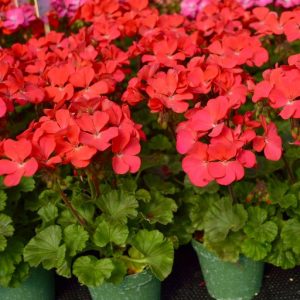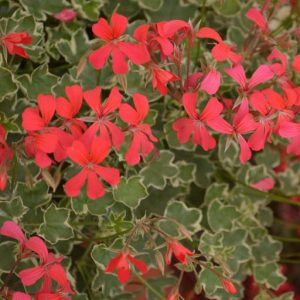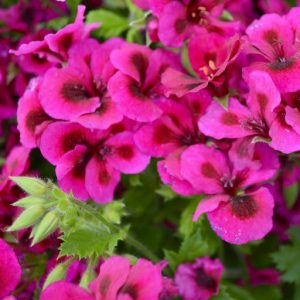
Continuous, vibrant flowers make common geranium (Pelargonium x hortorum) a garden classic, especially in containers. (Photo: Helen Battersby)
The name “geranium” is often given to two members of the geranium family (Geraniaceae). However, the name really belongs to only one of them – the hardy perennial geranium, also known as a cranesbill (Geranium). The other geranium is a tender perennial, not hardy in Canada, and usually grown as an annual in containers or sunny flower beds. When these attractive flowering plants were first introduced from South Africa, they were misclassified as being in the same genus as the perennial geranium. When you buy “geraniums” to plant in your window boxes, think of them by their true botanical name: Pelargonium.
The genus Pelargonium includes an estimated 230-300 species and subspecies of annuals, perennials and subshrubs. Most come from South Africa with a few from the Middle East and Australia. They come in many shapes and sizes, and can range from tiny to over 1.8 metres (6 feet) in height. In areas with cold winters, they are generally treated as annuals.
Pelargoniums are excellent bedding plants and are particularly effective when planted in masses. They are also unsurpassed as container plants. Smaller varieties make excellent houseplants.
Classification of pelargoniums is confusing, and experts advise that many identical plants can be called by several different names. Pelargoniums have been informally classified into 4 basic types:
- Common or Zonal: Pelargonium x hortorum. Upright and bushy, with succulent stems, roundish leaves that may have a dark c-shaped band, single or double flowers on long stalks, often used as bedding plants. Most are 30-60 cm (1-2 feet tall), although dwarfs and miniatures exist.
- Ivy-leaved: Pelargonium peltatum. Trailing growth habit, leaves frequently smooth, waxy and shiny with pointed lobes (like ivy!), long stems, flowers single or double
- Regal or Martha Washington: Pelargonium x domesticum. Bushy, with roundish leaves that have coarse teeth and may be scented, flowers primarily single. Angel hybrids are similar to regals but smaller with single flower heads.
- Scented-leaf: e.g., rose-scented (P. capitatum), lemon (P. crispum), peppermint (P. tomentosum). Shrubby, with scented and frequently lobed, toothed or variegated hairy leaves, grown primarily for the fragrance of the leaves, rather than flowers.
- You may have also noticed plants labelled as Interspecific hybrid geraniums in garden centres. These newer geraniums are a cross between the zonal geranium and the ivy-leaved geranium, combining the heat and drought tolerance of the zonal geranium with the heavier bloom and more trailing habit of ivy geraniums.
How to grow
When grown outdoors, pelargoniums require a well-drained soil and tolerate a range of pH. Zonal pelargoniums grow best in full sun, while regal cultivars prefer partial shade conditions and cooler growing conditions. Ivy-leaved cultivars enjoy moderate temperatures and like afternoon shade, as well as constant moisture levels. Plant outdoors as soon as there is no danger of frost.
Pelargoniums do not like hot, humid conditions. They prefer average moisture but can withstand periods of drought. Water sparingly when the temperature is cool, and more frequently during hot spells. To help prevent disease problems, water early in the day, allowing the foliage to dry before night. Limp foliage indicates that the plant needs water. Do not overwater: pelargoniums dislike both excess water and humidity.
Container plants usually need more fertilizer than those planted directly in the ground. Use a fertilizer high in phosphorus and potassium, but low in nitrogen, to encourage flowering and plant vigour rather than leafproduction. Feeding with a high nitrogen fertilizer will result in all leaves and no blooms.
As houseplants, pelargoniums enjoy a sunny spot with good air circulation. They require well-draining potting soil and thorough watering when the soil surface is dry. Applications of a high phosphorous fertilizer at half strength once a month (not during November through February) is recommended. They prefer cool nights. For more on growing pelargoniums indoors, see https://hgic.clemson.edu/factsheet/growing-geraniums-indoors/.
Pinch back the growing tip in early spring to encourage bushiness, branching and more flower production. Remove spent flowers to encourage more blooming.
Propagation and Overwintering
Pelargoniums can be grown from seed, stem or leaf cuttings, or root divisions. Many people prefer to take stem cuttings, where an 8-10 cm (3-4 inch) length of stem containing 3 or 4 nodes should be cut, with only 1 or 2 leaves left on the cutting. Prepare a container with good well-aerated potting soil and insert the cutting around 2.5 cm (1 inch) into the soil, with at least 2 nodes buried below the surface. Tamp down the soil gently and water, then water again when the soil is dry – do not let the cutting dry out. Keep in a sunny, warm spot, and the cutting should root in 3-4 weeks. Once rooted, transfer to a 10 cm (4-inch) pot and fertilize with a balanced 20-20-20 fertilizer. This is also a good way to keep plants overwinter if your storage space inside is limited.
If you have a sunny location indoors, outdoor plants can be cut back, potted up and moved inside before nighttime temperatures dip below 7°C (45°F), to a bright spot (a south-facing window is ideal) where they can get at least 4 hours of direct sunlight each day. If grow lights are used, prune the plants every couple of months if they get leggy. In late spring, prune, repot and harden off the plants before moving them outside again.
Bareroot storage is another way to overwinter outdoor plants. Before the first frost, lift the plants out of the ground and cut them back by at least one third, removing dead leaves, stems and other matter that might decay, to prevent fungus. Shake dirt off the roots and hang the plants upside-down in a cool, moist basement, shed or garage where they will not freeze. From time to time take them down and soak the roots in water to prevent them from drying out too much. Once spring arrives, remove at least half of the new (top) growth, then pot them up or plant them outdoors.
For more on overwintering pelargoniums, see https://empressofdirt.net/overwintering-geraniums/ and https://blog.thompson-morgan.com/overwintering-geraniums/
Pests and diseases
Most pests or diseases that may afflict pelargoniums are not unique to these plants. For a fuller discussion, see:
Missouri Botanical Garden. Problems common to many indoor plants. https://www.missouribotanicalgarden.org/gardens-gardening/your-garden/help-for-the-home-gardener/advice-tips-resources/visual-guides/problems-common-to-many-indoor-plants.aspx
The University of California. IPM program. How to manage pests: Geraniumhttp://ipm.ucanr.edu/PMG/GARDEN/FLOWERS/geranium.html
References and Resources
RHS. How to grow pelargoniums. https://www.rhs.org.uk/plants/pelargonium/growing-guide
Herb Society of America. Pelargoniums. An Herb Society of America Guide 2006 (https://www.herbsociety.org/file_download/inline/2b2f9fc8-e827-446c-99da-1c1e8b6559d0)
Perry, L. Geraniums or pelargoniums? University of Vermont Extension. (https://pss.uvm.edu/ppp/articles/geraniums.html)
Date prepared: May 2022
Prepared by the Toronto Master Gardeners, these Gardening Guides provide introductory information on a variety of gardening topics. Toronto Master Gardeners are part of a large, international volunteer community committed to providing the public with horticultural information, education and inspiration. Our goal is to help Toronto residents use safe, effective, proven and sustainable horticultural practices to create gardens, landscapes and communities that are both vibrant and healthy.
Statement on Invasive Plants: When choosing plants, avoid invasive plants, which can spread quickly and dominate gardens. Invasive plants are sold by nurseries, big box stores or even at community plant sales. Invasives may already be present in your garden. They can invade gardens by spreading from under a neighbour’s fence or may be transported by wildlife. For beautiful, sustainable options to invasive plants, see the Ontario Invasive Plant Council’s “Grow Me Instead – Beautiful Non-Invasive Plants for your Garden” at https://www.ontarioinvasiveplants.ca/resources/grow-me-instead/before purchasing or accepting “gifts” of plants.
Statement on Home Remedies: The Toronto Master Gardeners do not recommend home remedies, as these have not been proven effective through scientific investigation, and may even damage other living organisms in the soil or plants in your garden. There are other garden friendly options you can use.
If you have further gardening questions, reach us at our gardening advice line 416 397 1345 or by posting your question here in the Ask a Master Gardener section. To book Toronto Master Gardener volunteers for talks, demonstrations, advice clinics, or other services, please contact us at 416 397 1345 or bookamg@torontomastergardeners.ca

Variegation on the edges of this cultivar outlines the leaf shape that gives Ivy-Leaf Pelargonium its common name. (Photo: Helen Battersby)


